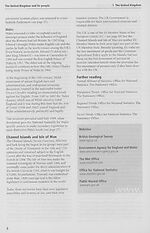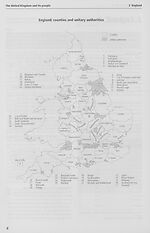Download files
Complete book:
Individual page:
Thumbnail gallery: Grid view | List view

2 England
Population 7
Representation at Westminster
and in Europe 7
Population
Nearly 84 per cent of the total population of the
United Kingdom lives in England, mainly in the
major cities and metropolitan areas in London
and the South East, South and West Yorkshire,
Greater Manchester and Merseyside, the West
Midlands, and conurbations on the rivers Tyne,
Wear and Tees. The population of England almost
trebled between 1851 and the end of the 20th
century. Table 2.1 shows that the South West, East
and South East regions each grew by more than 10
per cent between 1981 and 2001.
England is by far the most densely populated part
of the UK. In 2001 it had a population density of
377 people per sq km compared with Wales (140),
Northern Ireland (124) and Scotland (64).
In contrast to Northern Ireland, Scotland and
Wales, England has no separate elected national
body exclusively responsible for its central
administration (see chapters 3, 4 and 5). Instead
Table 2.1 England population and
population change, by region,1 2001
Population Change in
(thousands) population
1981-2001
W
North East 2,517 -4.5
North West 6,732 -3.0
Yorkshire and the Humber 4,967 1.0
East Midlands 4,175 8.4
West Midlands 5,267 1.6
East 5,395 1 1.1
London 7,188 5.6
South East 8,007 10.5
Southwest 4,934 12.6
England 49,181 5.0
1 These are the areas covered by Government Offices - see map on
page 8.
Source: Office for National Statistics
Structure of local government 7
The regions of England 9
a number of government departments look after
England’s day-to-day administrative affairs (see
Appendix A) and there is a network of nine
Government Offices for the Regions (GOs - see
page 9). However, in the longer term, the
Government is committed to providing for
directly elected regional assemblies in those
regions that want them (see page 10).
Representation at Westminster and in
Europe
There are 529 English parliamentary constituencies
represented in the House of Commons (see
Table 2.2). Conservative support tends to be
strongest in suburban and rural areas, and the
party has a large number of parliamentary seats in
the southern half of England. The Labour Party’s
key support comes mainly from the big cities and
areas associated with heavy industry, but it
currently holds many seats which had in the past
been considered safe Conservative constituencies.
The Liberal Democrats, who are traditionally strong
in the South West, now have over a third (15) of
their English seats in Greater London and the
South East.
A Standing Committee on Regional Affairs was
revived in April 2000. It consists of 13 Members
sitting for constituencies in England and reflects
party representation in the House. Any Member
representing an English constituency may take
part in its proceedings, but they may not make
a motion, vote or be counted in the quorum. The
committee considers issues specific to the English
regions.
Structure of local government
In many areas of England a two-tier system of
county and district councils is responsible for
government at the local level. However, there are
also a number of single-tier, or unitary, authorities
- especially in the larger cities (see map on page 8).
Some ‘borough’ or ‘city’ councils are unitary and
others operate at the district level. Since July 2000
the strategic government of London has been the
7
Population 7
Representation at Westminster
and in Europe 7
Population
Nearly 84 per cent of the total population of the
United Kingdom lives in England, mainly in the
major cities and metropolitan areas in London
and the South East, South and West Yorkshire,
Greater Manchester and Merseyside, the West
Midlands, and conurbations on the rivers Tyne,
Wear and Tees. The population of England almost
trebled between 1851 and the end of the 20th
century. Table 2.1 shows that the South West, East
and South East regions each grew by more than 10
per cent between 1981 and 2001.
England is by far the most densely populated part
of the UK. In 2001 it had a population density of
377 people per sq km compared with Wales (140),
Northern Ireland (124) and Scotland (64).
In contrast to Northern Ireland, Scotland and
Wales, England has no separate elected national
body exclusively responsible for its central
administration (see chapters 3, 4 and 5). Instead
Table 2.1 England population and
population change, by region,1 2001
Population Change in
(thousands) population
1981-2001
W
North East 2,517 -4.5
North West 6,732 -3.0
Yorkshire and the Humber 4,967 1.0
East Midlands 4,175 8.4
West Midlands 5,267 1.6
East 5,395 1 1.1
London 7,188 5.6
South East 8,007 10.5
Southwest 4,934 12.6
England 49,181 5.0
1 These are the areas covered by Government Offices - see map on
page 8.
Source: Office for National Statistics
Structure of local government 7
The regions of England 9
a number of government departments look after
England’s day-to-day administrative affairs (see
Appendix A) and there is a network of nine
Government Offices for the Regions (GOs - see
page 9). However, in the longer term, the
Government is committed to providing for
directly elected regional assemblies in those
regions that want them (see page 10).
Representation at Westminster and in
Europe
There are 529 English parliamentary constituencies
represented in the House of Commons (see
Table 2.2). Conservative support tends to be
strongest in suburban and rural areas, and the
party has a large number of parliamentary seats in
the southern half of England. The Labour Party’s
key support comes mainly from the big cities and
areas associated with heavy industry, but it
currently holds many seats which had in the past
been considered safe Conservative constituencies.
The Liberal Democrats, who are traditionally strong
in the South West, now have over a third (15) of
their English seats in Greater London and the
South East.
A Standing Committee on Regional Affairs was
revived in April 2000. It consists of 13 Members
sitting for constituencies in England and reflects
party representation in the House. Any Member
representing an English constituency may take
part in its proceedings, but they may not make
a motion, vote or be counted in the quorum. The
committee considers issues specific to the English
regions.
Structure of local government
In many areas of England a two-tier system of
county and district councils is responsible for
government at the local level. However, there are
also a number of single-tier, or unitary, authorities
- especially in the larger cities (see map on page 8).
Some ‘borough’ or ‘city’ councils are unitary and
others operate at the district level. Since July 2000
the strategic government of London has been the
7
Set display mode to:
![]() Universal Viewer |
Universal Viewer | ![]() Mirador |
Large image | Transcription
Mirador |
Large image | Transcription
The item on this page appears courtesy of Office for National Statistics and may be re-used under the Open Government Licence for Public Sector Information.
| Britain and UK handbooks > UK: The official yearbook of the United Kingdom of Great Britain and Northern Ireland > 2003 > (17) |
|---|
| Permanent URL | https://digital.nls.uk/204923316 |
|---|
| Attribution and copyright: |
|
|---|---|
| Description | Three volumes of 'UK: The official yearbook of the United Kingdom of Great Britain and Northern Ireland', published annually by the Office of National Statistics from 2002-2005. |
|---|---|
| Shelfmark | GII.11 SER |
| Description | Three titles produced by the British Government from 1954-2005 describing 'how Britain worked'. They are: 'Britain: An official handbook' (1954-1998), 'Britain: The official yearbook of the United Kingdom' (1999-2001), and 'UK: The official yearbook of the United Kingdom of Great Britain and Northern Ireland' (2002-2005). These 50 reports provide an overview of Britain's economic, social and cultural affairs, its environment, international relations, and the systems of government. They give an impartial summary of government policies and initiatives, and explain how public services are organised. |
|---|---|
| Additional NLS resources: |
|

